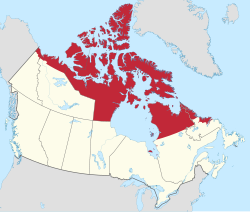
Back Inuit Nunangat Spanish Inuit Nunangat French Inuit Nunangat NN Inuit Nunangat Polish 因紐特人努那屹 ZH-YUE
Inuit Nunangat
ᐃᓄᐃᑦ ᓄᓇᖓᑦ | |
|---|---|
Inuit Regions of Canada | |
 | |
| State | Canada |
| Regions | Inuvialuit Settlement Region Nunavut Nunavik Nunatsiavut |
| Province / Territory | YT, NT, NU, QC, NL |
| Area | |
• Total | 3,304,740 km2 (1,275,970 sq mi) |
| • Land | 2,484,591 km2 (959,306 sq mi) |
| • Water | 820,149 km2 (316,661 sq mi) |
| Population (2021)[1] | |
• Total | 58,220 |
| • Density | 0.018/km2 (0.046/sq mi) |
| Ethnicity population | |
| • Inuit | 48,695 |
| • First Nations | 980 |
| • Métis | 325 |
| • Other Indigenous | 500 |
| • Non-Aboriginal | 7,715 |
| Time zone | UTC−08:00 (PST) UTC−07:00 (MST) UTC−06:00 (CST) UTC−05:00 (EST) UTC−04:00 (AST) |
| • Summer (DST) | Varies |
| Inuit languages (west to east) | Inuvialuktun Inuinnaqtun Inuktitut Inuit Sign Language Inuttitut |
| Website | www |
Inuit Nunangat (/ˈɪnjuɪt ˈnunæŋæt/;[citation needed] Inuktitut: ᐃᓄᐃᑦ ᓄᓇᖓᑦ [inuit nunaŋat] 'the place where Inuit live'[2]), formerly Inuit Nunaat (ᐃᓄᐃᑦ ᓄᓈᑦ), refers to the land, water, and ice of the homeland of the Inuit in Canada. This Arctic homeland consists of four northern Canadian regions called the Inuvialuit Settlement Region (Inuvialuit Nunangit Sannaiqtuaq, home of the Inuvialuit and the northern portion of the Northwest Territories and Yukon), the territory Nunavut (ᓄᓇᕗᑦ), Nunavik (ᓄᓇᕕᒃ) in northern Quebec, and Nunatsiavut of Newfoundland and Labrador.
© MMXXIII Rich X Search. We shall prevail. All rights reserved. Rich X Search